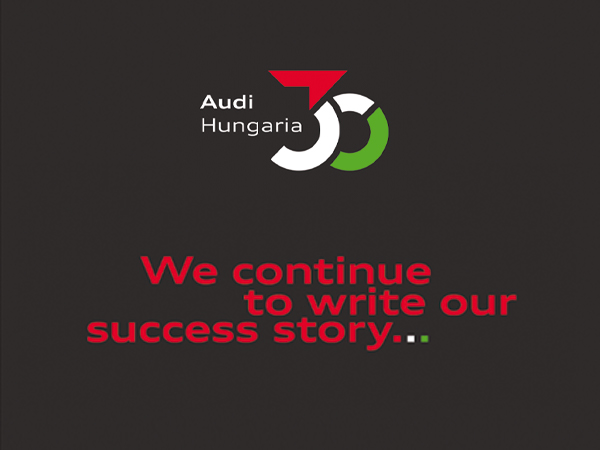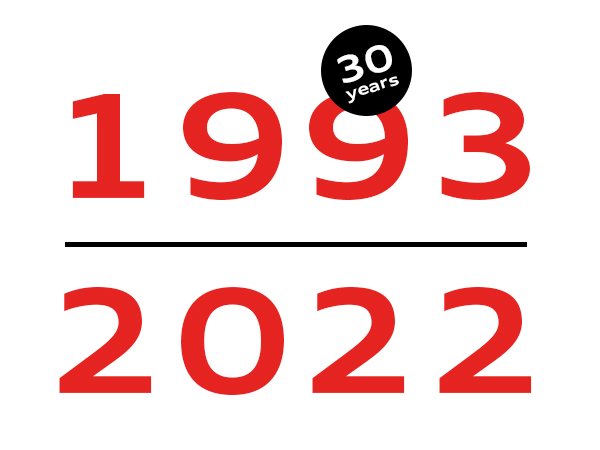
Thirty years of ...from Győr to the world
Three decades that have made Audi Hungaria forever synonymous with both Hungarian engine and vehicle production and the city of Győr. So what has happened over the course of those 30 years? Below, we proudly tell you the tale, focusing on the most significant milestones in our history.
Audi Hungaria is born. AUDI AG has created the most cutting-edge petrol engine in the world, with four five-valve cylinders. The engine requires a new production facility. The German giant examines 180 potential sites before deciding on Győr, a city in Western Hungary. The decision is influenced not only by the city’s proximity to German-speaking regions, but also for its industrial and educational traditions. It signals a new, fruitful era in the life of the city. It has not been long since the fall of communism, and now Győr will become an ultra-modern industrial centre, providing a new livelihood for thousands of people. This is the start of a beautiful friendship between Győr and Audi.
I remember the red metal columns in the half-finished hall in 1993. There were some sheds opposite, and we had to walk around on wooden platforms when it rained. Even then, the company was a truly special one: it was filled with this really warm, human atmosphere. The shared goal brought us together, regardless of what area we were working in. To this day, whenever we are all pulling together, it still stirs my heart.

Head of Powertrain Experiments/ Acoustics/ VZO
The hustle and bustle around the half-finished 100,000-m2 hall – which previously belonged to the Rába automotive company – is dying down, and all the work is now taking place inside. The structure of the gigantic plant is ready, and engine assembly and processing production lines have begun trial operations. Győr is booming: everyone knows the opportunities are enormous. What they also feel, though, is the weight of responsibility. They have to meet the expectations of German industrial culture. Yet there is also a feeling in the air that somehow this won’t be aproblem. After test runs, series production begins. Hungarian president Árpád Göncz presses the button to launch a string of successes that has lasted three decades and counting.
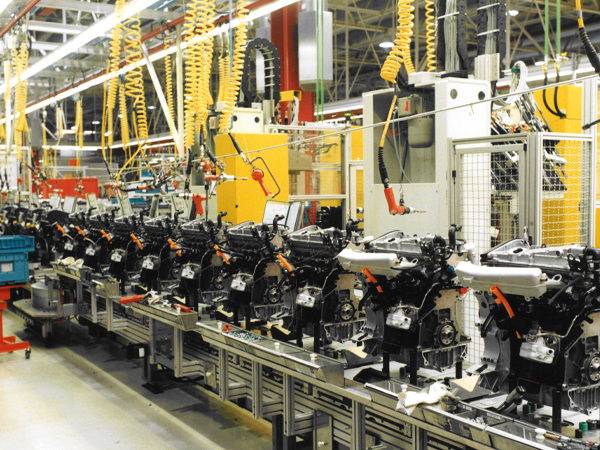
As Hungary’s southern neighbours bring a long fratricidal war to a close with the Dayton Agreement and conclude a fragile peace, Hungary takes its first steps on the road to prosperity. Not only does the Hungarian Parliament accept the ‘currency law’, which means the forint can now be converted, but production at the Audi factory in Győr also sets off at full steam. Little time is spent on the orientation process one might expect at a new factory. Instead, the foot is firmly on the accelerator – so much so, that, by the end of the year, the 100,000th engine rolls off the production line.
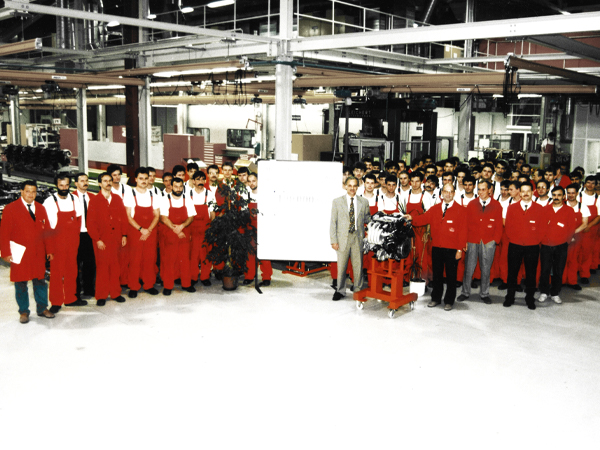
Hungary joins the OECD, the Organisationfor Economic Co-operation and Development. The country has an increasing number of ties to the West, with ever more connections to the main arteries of the global economy. In the meantime, close to Győr, a custodian of a thousandyear- old culture – the Benedictine Pannonhalma Archabbey and its natural surroundings – are named a World Heritage Site. The Győr factory is booming, and production begins for a new product: a 1.6-litre, two-valve aluminium engine. But some new stars are also knocking at the door in the form of two powerful motors, the V6 and V8engines, and the TT model, as Győrgradually progresses into becoming a bona-fide car manufacturer.
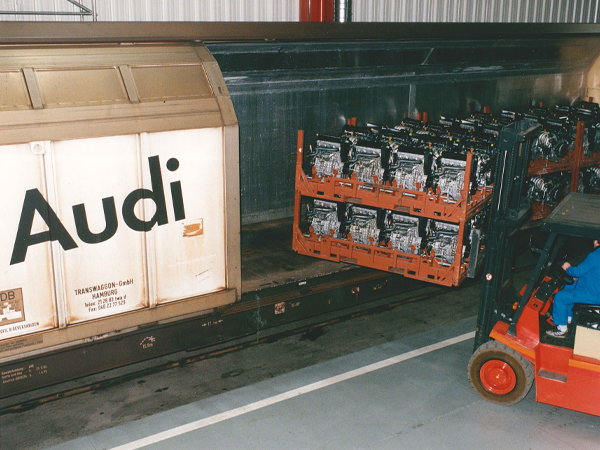
A year of big developments as we lay the groundwork to move up a gear. The country also takes a leap forward: from 1 January, Hungarian citizens are freely able to exchange their money – if they want to, they can even use it to buy an Audi, including from abroad. (Fortunately, there is already a well-established sales network in Hungary by this time.) And as Hungary negotiates its entry into NATO, work is proceeding at fever pitch in Győr. With the production of six- and eight-cylinder engines, we have to develop logistics too, and a new, 30,000-m2 hall is built, with trains used to transport the finished products. But there is something else in the air: there is a great sense of anticipation.
I am proud to have been involved in every aspect of the construction of the factory over the last 22 years. I feel like, during this time, I have grown along with the factory. I became an adult, and a mother as well. I have gained a wealth of experience and working knowledge, and taken part in numerous projects that have left me with a great feeling of satisfaction.
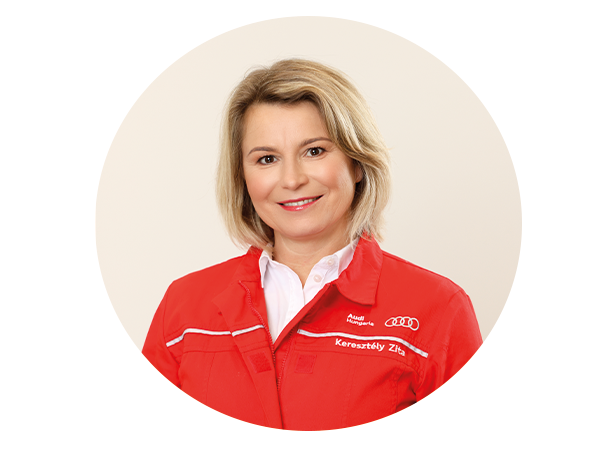
Corporate Protection/ Real Estate Structural planner
We all know that expression that comes over the face of someone we know when they first set eyes on the Audi TT. Eyes wide open, jaw dropped… This miracle of design comes with an instant urge for ownership. Whether they admit it or not, everyone wants one. No matter if the TT is a Coupé or even a feisty little Roadster, it is a true masterpiece of engineering. The painted coupé bodywork is transported from Ingolstadt to Győr, where 550 of our highly qualified colleagues work in a 35,000-m2 hall across three shifts to assemble the street sports cars. In Győr, the project breathes new life into vehicle production. AUDI AG orders more capacity for Hungary, and fuel injecton diesel engines are produced on the increasingly crowded production lines.
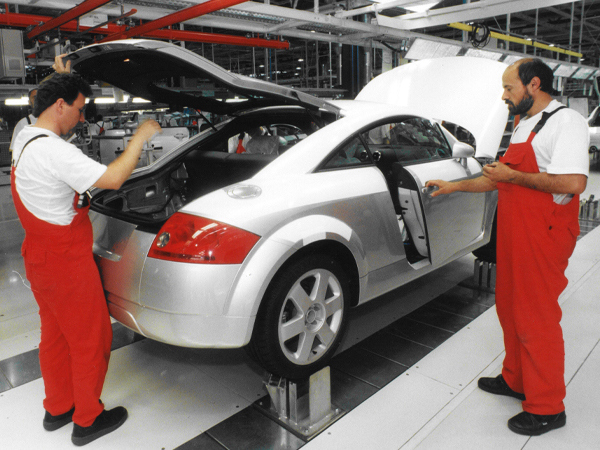
On 1 January, the euro is introduced in the European Union. In Győr, Road 100, which traverses the city, is ‘rechristened’ Road 1. In March, Hungary joins NATO. At the cinema, you can watch The Matrix and The Sixth Sense, with The Phantom Menace, the first part of the Star Wars prequel trilogy, on its way. It’s busy year, with Győr adding to the activity: we present the TT Roadster, made on site. While the TT Coupé sent even moderate car enthusiasts into ecstasy, the TT Roadster brought an even bigger rush of adrenaline and endorphins. All cars are cooler without a roof – it sends the message that the owner is an open person who enjoys life and sunlight, and doesn’t take themselves too seriously. In other words: they are happy.

If we look back to our childhoods, many of us expected to see flying cars, infinite wealth and alien contact by the turn of the century. In the 1990s, however, we were worrying about the Y2K bug instead: that the date change would cause computers to crash and the digital world to collapse. Instead, we calmly sailed through into a new millennium. In Győr, Prime Minister Viktor Orbán writes in the guestbook: “When I first entered the site of the company, I hadn’t yet realised I had arrived in the future.” The prime minister makes his assessment from behind the wheel of an Audi TT, and also views some of the latest models – the A3 and S3, both made in Győr.
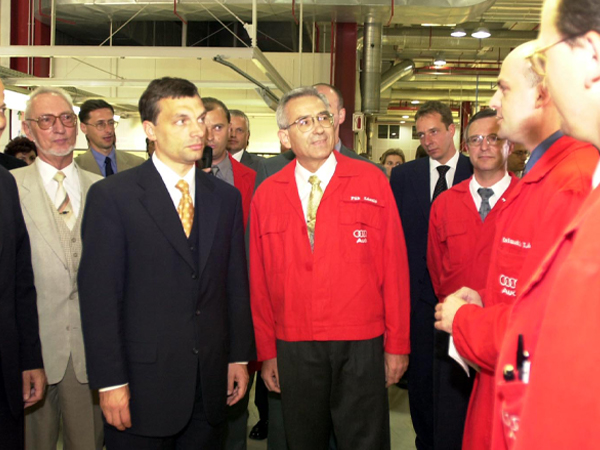
It’s worth rewatching the terrifyingly brilliant 2001: A Space Odyssey, the Stanley Kubrick film adapted from the book by Arthur C. Clarke. In the visionary film, artificial intelligence rebels against its makers, giving us a vision of what it’s like when knowledge falls into the wrong hands. In Győr, however, it is in good hands, and keeps piling up. Audi Hungaria founds the Engine Development Centre and institutionalises knowledge transfer – because it is not only physical energies that modern factories concentrate in one place, but intellectual ones as well. Partnership agreements are established with the Lukács Sándor Vocational School in Győr and Széchenyi István College, where “The Modern Company – AUDI HUNGARIA MOTOR Kft.” will become a special field of study.
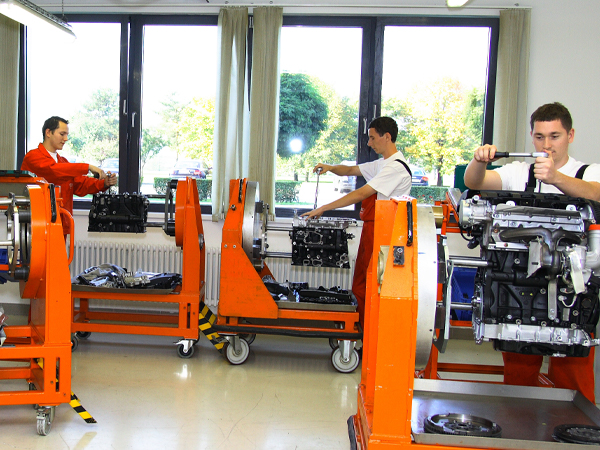
There is visible progress in Győr year after year. While 2001 saw Audi partner with Széchenyi István College, the institution of higher education now becomes a university. History continues on its own path, often bringing change with it. Nothing signifies this better than the fact that, in 2002, Péter Medgyessy, the new Hungarian prime minister, opens a new hall on the Audi factory site. This year sees the entire company engaged in feverish development. In summer, production begins of direct injection two-litre TSI engines, while, in autumn, both the six-cylinder petrol FSIs and the co-injection TDI units start to roll off the production lines.

What makes 2003 such an important year isn’t just that Hungary holds a referendum regarding EU membership. (Incidentally, this year also marks the establishment of the foundation that created Wikipedia, one of the most popular initiatives on the internet.) As Hungarians decide they want to enter the EU, in economic terms the country has already been there for a while, as 2003 marks ten years of Audi Hungaria. By the time of the anniversary, it is the largest engine factory in the world. The company has created a strong bond between Germany and Hungary, which ties us to Europe in terms of business, culture, and our colleagues. The first Audi charter plane arrives at the redesigned airport in Pér, reducing the travel time between Ingolstadt and Győr to a nominal one hour.
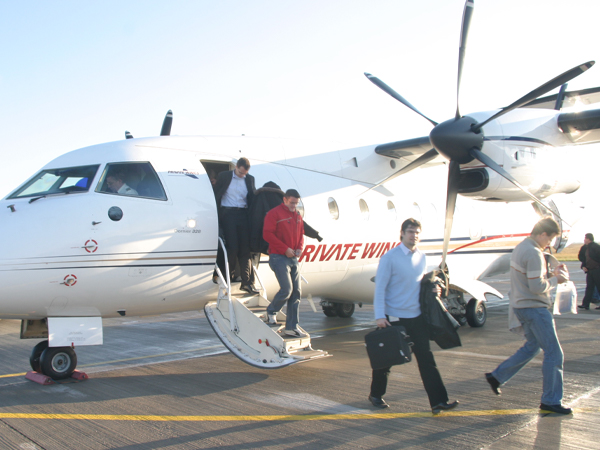
Hungary has arrived: together with nine other countries, it joins the European Union. German band Rammstein releases the album Reise, Reise. The Cassini-Huygens space probe orbits Saturn. In Győr, to celebrate their 100th anniversary, the local football club – with Audi’s assistance– welcome a Bayern Munich legends team to the pitch. In the meantime, another kind of community is also taking shape: there is an aromatic cloud of Hungarian flavours hovering above the factory during the first ever Cooking Day, involving 3,000 of our colleagues and 53 teams.
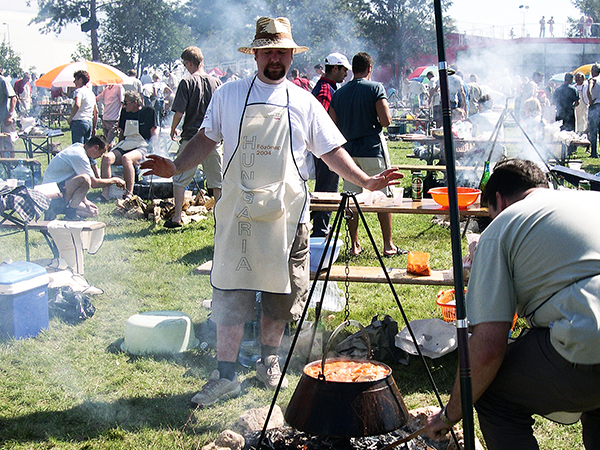
A new era begins in Germany, as Angela Merkel is elected chancellor. In Hungary, László Sólyom is the new president, and Győr ETO’s Anita Görbicz is voted the best handball player in the world. This is not the only reason that Győr makes the news, however, as there is also one amazing figure: the 10 millionth Audi engine rolls off the production lines – a 1.8-litre, four-cylinder, five-valve turbo with 225 horsepower. Where else could it be assigned but to a Győr Audi TT police car – a white lightning bolt on the motorway. In the meantime, a tool factory is also completed in Győr, and a stream of bodywork parts and tools pours out of the 18,000-m2 facility.
In 1994, I was one of the first 200 workers, and in July 2011 I applied to work in the pressing plant. It was new, so I was curious about it, and I also wanted to improve my German. I’ve always been interested in German precision and culture, its exactness. I love my job: I feel secure at Audi, and I work as if I were working on behalf of my own business.
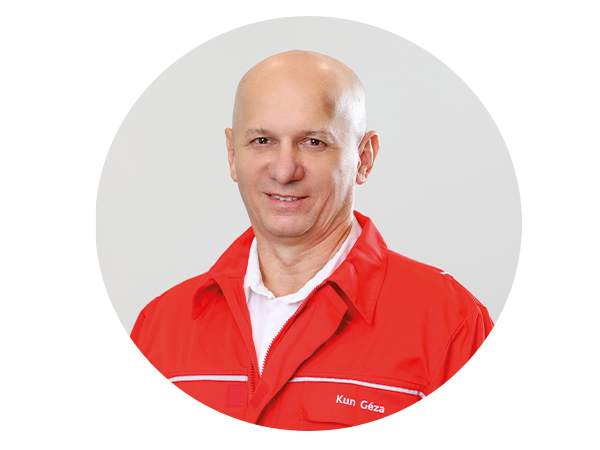
Pressing Plant, Shift Supervisor
According to a statement from the US Census Bureau, the population of the Earth will reach 6.5 billion at 1.16 am on 26 February. In November, the domino world record is broken in the Dutch city of Leeuwarden at Domino Day 2006. In Győr, the work is relatively quiet this year, and though there are no new records, everything runs smoothly throughout the company. For the 50th anniversary of the 1956 revolution, for example, a fleet of 80 A8s with extended wheelbases transports rulers and leaders from all over the world around Budapest. Audi becomes the naming sponsor of the Győr ETO women’s handball team, and the plant starts production of the ten-cylinder (!), 5.2-litre FSI engines and the next generation of the TT.

Automotive journalists are often sent to the most beautiful places around the world, where they can be captivated not only by the vehicles, but also by the amazing locations. This year, the Audi C3 Cabriolet is presented in two of the most beautiful places on the planet, Lake Balaton and Budapest. After all, cruising around the town of Tihany or through the Budapest Castle District in an Audi could easily be at the top of anyone’s bucket list. Hungarian singer Zséda (Adrienn Zsédenyi) provides the music to get those feet (and tyres) tapping for the world premiere. One slightly more formal announcement from this year is the launch of the Internal Combustion Engines Department at Széchenyi István University, as well as the launch of SCC services provided by the company in the areas of finance, IT and procurement.
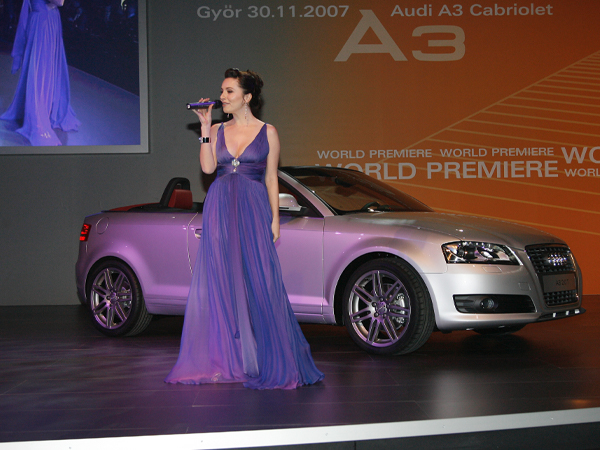
Due to an attack on French tourists in Mauritania, organisers decide to cancel the 2008 Lisbon-Dakar rally – the first time the event hasn’t taken place since 1979. Fortunately, the Hungarian Wine Road Rally still goes ahead. The rally has two important objectives: to promote Hungarian wine regions and to emphasise that everyone should drive safely and avoid accidents – though competitors can still taste the best vintages of the given terroir in the evenings. Everyone especially appreciates the display of self-restraint, which is no wonder, as Audi has provided 120 orange TT Coupés for the event. Let the ‘chase’ begin! The police force is also expanding, with a lightning-fast 272 bhp TT S Coupé. And speaking of performance: a sophisticated monster of an engine, the V12 six-litre TDI engine, is being built in Győr.
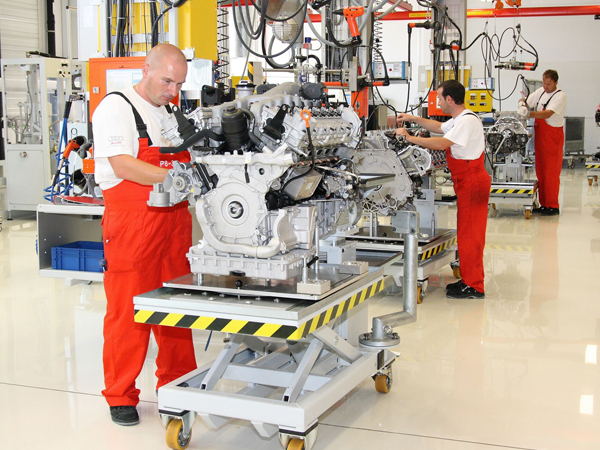
In May, Anita Ugyan becomes the first Hungarian woman to reach the top of Mount Everest as a member of an international expedition. In the meantime, the UN climate summit in Copenhagen ends on a somewhat disappointing note: the declaration issued is less than concrete. In Győr, on the other hand, climate neutrality and nature conservation are taken increasingly seriously. More than 13,000 sessile oaks are planted by leaders from Audi, the city of Győr, as well as from its two universities, which are investigating the carbon sequestration capacity of a forest growing from saplings. In the factory, assembly of a new engine begins: the 2.5-litre, five-cylinder unit wins the first of its nine International Engine of the Year awards. These massive mechanical hearts also start beating in the new TT RS.

In 2010, the UN proclaims the International Year of Youth, and in March, Charles, Prince of Wales, visits Hungary together with his wife, Princess Camilla. The visit focuses on climate change, environmental protection, the preservation of cultural heritage, the knowledge economy and equal opportunities. Culture, knowledge and future generations are also priorities in Győr. In September, the company supports the launch of instruction at the Audi Hungaria German Primary and Secondary School, where pupils begin studying in both Hungarian and German. In May, the Kölyök-KRESZ Program (Junior Driving Programme) is launched, where more than a thousand Győr preschoolers a year will have the chance to learn the rules of the road. Vehicle Development is also established, and the engines of the future take centre stage at the newly opened Experimental Engine Production Centre.
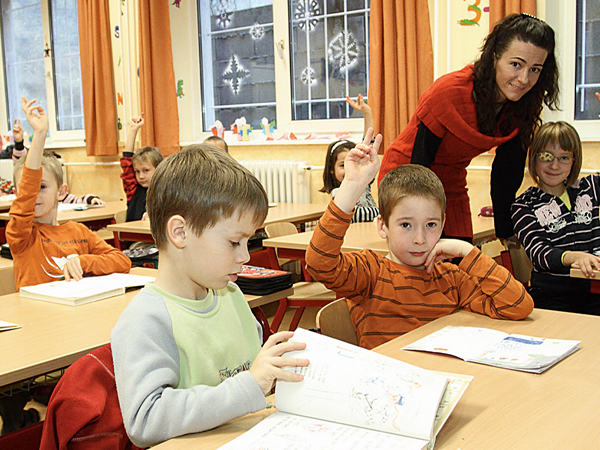
The UN proclaims 2011 the International Year of Forests. Audi’s subsidiary in Hungary is keeping its finger on the world’s green pulse: another 16,000 sessile oaks are planted in Hungary as the second stage of the reforestation project. In addition, from 1 January, Hungary takes over the rotating presidency of the European Union. For the entire year, it often feels a bit like everyone is focusing on Hungary. In Győr, the Hungarian prime minister Viktor Orbán and Rupert Stadler, chairman of the board of Audi AG, lay the foundation stone for an entirely new vehicle factory. October sees the opening of the Project and Training Centre, where our new colleagues will be trained. The FC Bayern Munich All Stars and ETO FC Győr clash at the ETO Arena – as much as you can ‘clash’ in a friendly match!
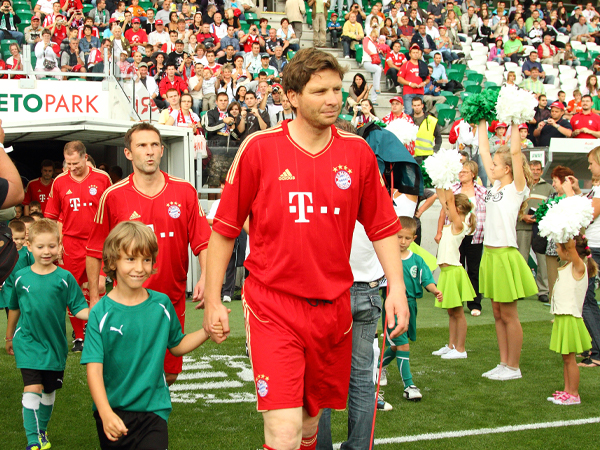
In Hungary, a new constitution is passed into law. Compact Disco wins the Hungarian selection for the Eurovision Song Contest with Sound of our Hearts and goes on to represent the country in the international competition. The first Hungarian satellite is sent into space: MASAT-1, a 10X10-cm cube. At CERN in Switzerland, it is announced that they have found the Higgs boson, the ‘God particle’ physicists have long sought. Science also makes an impact in Győr: after the developments of the previous year – when the Department of Internal Combustions at Széchenyi István University received a new building – 2012 sees the second phase with the construction of laboratories and education units. Audi is also taking care of younger children – from 2012, they can now attend a preschool facility at the Audi Hungaria School. The Engine Factory is also focused on ‘little ones’: 1.2 and 1.4-litre engines, whose main components are manufactured in Győr.
I was the first vocational trainer in the history of Audi Hungaria. I have had around 1,200 students over the course of ten years, many of whom have returned to the factory as employees. This anniversary is a really emotional one for me. Recently, one of my young colleagues asked me why 30 years is such a big deal – it turned out that he had just turned 30 himself. It was only then that he realised that by the time he was born, we had already started something that would eventually grow into this enormous factory.

Body shop, Analysis engineer
February sees some unbelievable global events: Pope Benedict XVI abdicates, and a meteorite the size of a bus explodes over the Chelyabinsk region of Russia, breaking all the windows in the area and injuring several people. Despite the unlucky start to the year, things couldn’t be better in Győr! Not only does the Audi ETO handball team win the Champions League, the factory also enjoys some unprecedented developments. The new Vehicle Factory is inaugurated, where the A3 saloon cars roll off the assembly line. The 270,000-m2 production area contains a pressing facility, a bodywork shop and painting and vehicle assembly areas, along with a central building, logistics hall and energy centre. The investment will create 2,100 new jobs at the company, helping boost the number of employees past the magical threshold of 10,000. A new logistics centre also opens its doors.
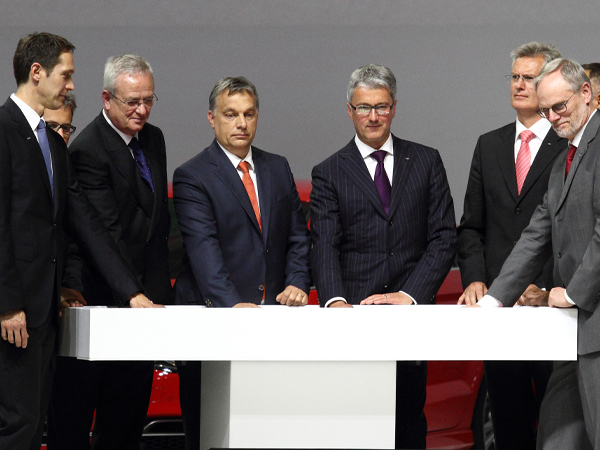
In Budapest, the M4 metro line and the renovated Castle Garden Bazaar are completed, while, with each passing year, Győr shows us that Hungarian cities outside the capital can develop nicely too, with the construction of a new, multifunctional hall with space for 5,500 spectators, for example. It isn’t hard to guess the name of the sponsor… Inside the factory, production of the new versions of the legendary TT begins: the addition of the Coupé and Roadster means that four Audi models are now made at the plant. The Tool Factory takes another step into the 21st century – as a new 3D laser cutter ‘sets up shop.’ The new developments also continue in the field of social responsibility. The Audi Hungaria Volunteers Day is organised for the first time, with 300 Audi employees involved in 19 charity projects.
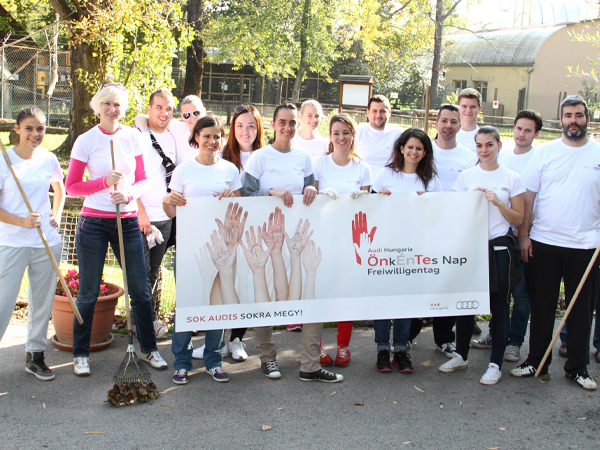
In May, László Krasznahorkai wins the Man Booker Prize, while in July the New Horizons space probe passes Pluto. In September, Elizabeth II becomes the longest reigning monarch in thehistory of the United Kingdom. December sees the premiere of The Force Awakens, the first film of the latest Star Wars trilogy. In Győr, however, the fact that geothermal energy now provides 60% of the company’s energy requirements is far from science fiction. The Bőny Thermal Centre reduces emissions of greenhouse gases by about 67,000 tons, and, thanks to the operation of the Győr Geothermal System, 35 million cubic metres less natural gas has to be burned. Speaking of millions, the two millionth engine is produced, and the Győr Philharmonic Orchestra gains a new sponsor. Yes: it’s Audi Hungaria.
I had an interview for an internship at Audi Hungaria on 18 February 2015. I have enjoyed my time at the company from the very start, and I really like working in two languages. The bond is also reinforced by the fact that I was born on the same day as the foundation of the company, so I hope that we can also celebrate our 30th birthdays together in 2023!
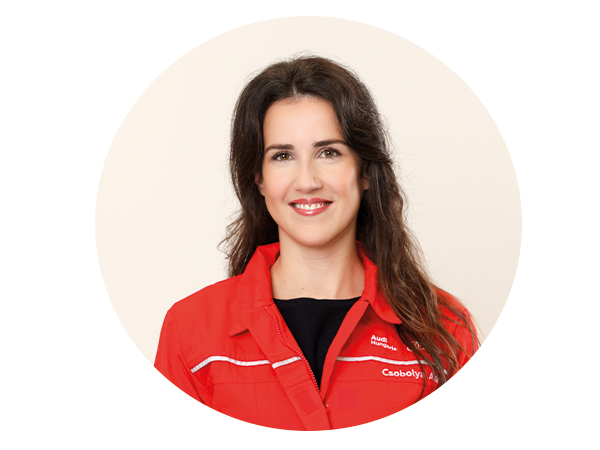
Tool Factory, Assistant
The reason Hungarians use the word ‘kuka’ for a rubbish bin is because the first bins in the country were made by a company called KUKA. Today, however, KUKA is also known for its industrial robots! On duty next to the production lines are two unusual workers: Adam and Eve. These special automatons of the ‘smart factory’ help assess the fit of the cars. Another robot hero, this one ‘anonymous’ and operating in self-learning mode, is responsible for tightening the screws. Training remains crucial, of course – at least for humans – and 2016 sees the expansion of the Audi Hungaria School, where a new sports facility is also built. At the start of the year, László Nemes Jeles won an Oscar for his film Son of Saul.
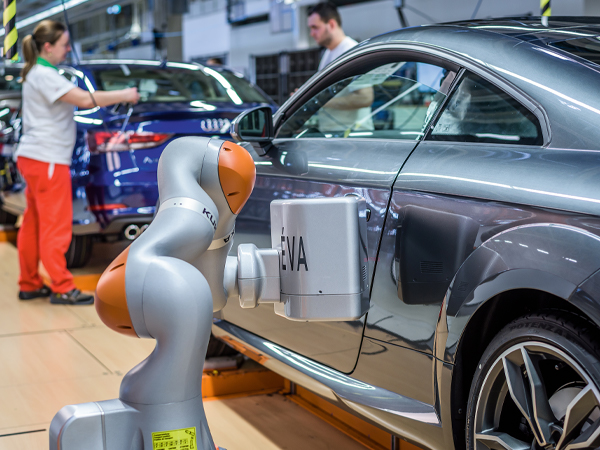
New times are coming, with new winds blowing. It is the start of electric motor production – everyone can feel that the great match of the future has to be won in Győr. ‘Conventional’ CNG engines, which run on natural gas and petrol, are now also made here. The Tool Factory undergoes an expansion, while preparations are underway for the production of a new model: the Q3s will soon set off on their world-conquering journey. A compact powerhouse also rolls off the production lines: the 400-horsepower engine helps the R3 saloon car fly like the wind. The progress in personnel is also evident, with more than 12,000 people now working in the enormous factory. Audi’s relationship with the city remains first class, and an Audi A4 Avant is added to the local ambulance service. The Olympic flame also passes through the site of the factory.
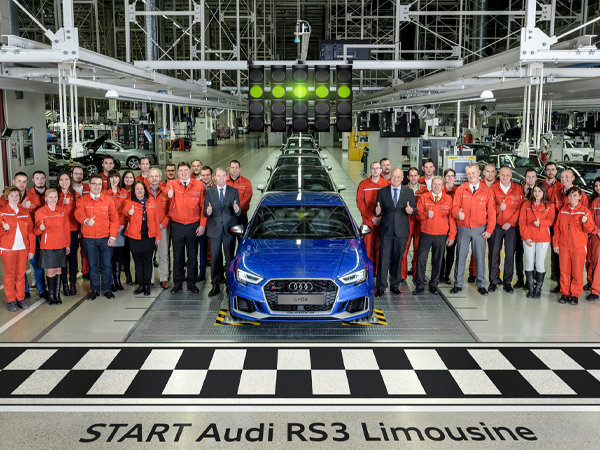
After 70 years, the Romanesque Hall at the Museum of Fine Arts in Budapest once again opens its doors to the public. In November, the world’s largest carp, at 51.2 kg, is caught in the Euro Aqua Lake next to Balatonederics. Richard Branson’s spacecraft SpaceShipTwo reaches the boundaries of space. In Győr, the first model of the second generation of Audi Q3s rolls off the production line. The world already has SUV-fever, and the Q3 only fans the flames. It is the fifth Győr model in the factory’s 25th jubilee year. By this point, Audi Hungaria is producing 9,000 engines and 700 cars a day across more than 5 million m2 of space, as series production of electric motors also begins.
It’s a great feeling to work in motor assembly, especially as a woman. Usually, men start tinkering around at home as children – looking under the bonnet with their dads… For me, on the other hand, everything was completely new, and I loved it straight away. This is because I am assembling the inside of the car, its soul, essentially. In the ten years I have spent here, I have always put my heart into my job.
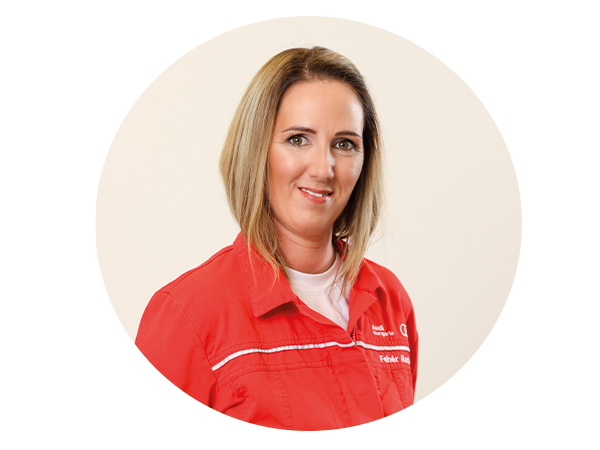
E-Motor, Assembly Operator
Pope Francis visits Șumuleu Ciuc (Csíksomlyó) in Transylvania. Ayers Rock, one of the most spectacular natural formations in Australia, is permanently closed to tourists. In Győr, on the other hand, a new academic department opens, representing a new milestone in the relationship between Széchenyi István University and Audi Hungaria. The Audi Hungaria External Department is formed and housed on-site in the Experimental Engine Production Centre. Series production begins of the Audi Q3 Sportback, the newest Győr model after the Audi A3 Cabriolet, the TT Coupé and Roadster, and the Q3. A silver Q3 Sportback is the first to leave the production line. Speaking of experimental engines, Audi Hungaria welcomes the electric era in every sense with the start of series production for the Q3 and Q3 Sportback models , which have mild hybrid (MHEV, Mild Hybrid Electric Vehicles) powertrains.

This year is not one of fond memories: in January, Brexit goes into force, and later on the coronavirus pandemic breaks out. The latter will shape the entire year, completely transforming our lives. Even this gloomy year brings some positive results, though. Audi Hungaria is able to cope with the downtime caused by the pandemic, and by June the factory is once again operating in three shifts. We even manage to complete Audi Hungaria’s first plug-in hybrid model, a turbo blue Audi Q3 Sportback. The development sees the company move to the next level in electromobility. Speaking of electricity: as part of a joint project between Audi Hungaria and the E.ON Hungária Group, Europe’s largest rooftop solar park is built on the roofs of two logistics centres in Győr, covering a total of 160,000 m2. This is a huge step towards the entire Audi Group having carbon-neutral operations by 2050.
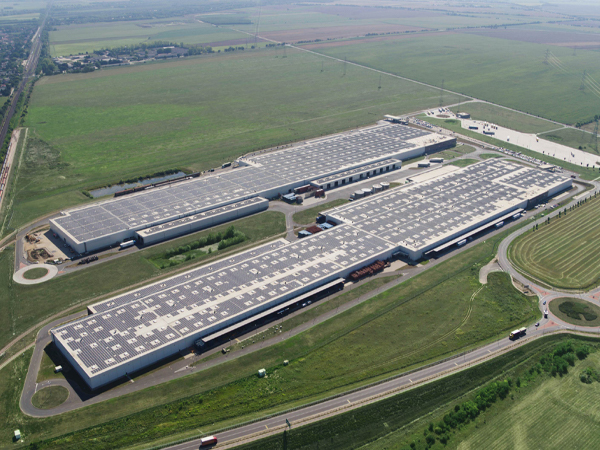
The NASA Perseverance rover makes a successful landing on Mars. In the same year, here on a planet called Earth, the 40 millionth engine rolls off the production lines at Audi Hungaria, a 190-horsepower (140 kW) electric powertrain, which is transported on CO2-neutral ‘green trains’ from Győr to Brussels, where it is fitted to a fully electric Audi e-tron model. This is the future: from now on, electric powertrains will be made in Győr for the group’s fully electric models, which are being built for the Premium Platform Electric (PPE), developed jointly with Porsche. The future outside the factory walls is also taking shape in other areas: the company commits to Győri Audi ETO KC and the Ballet Company of Győr for another three years.
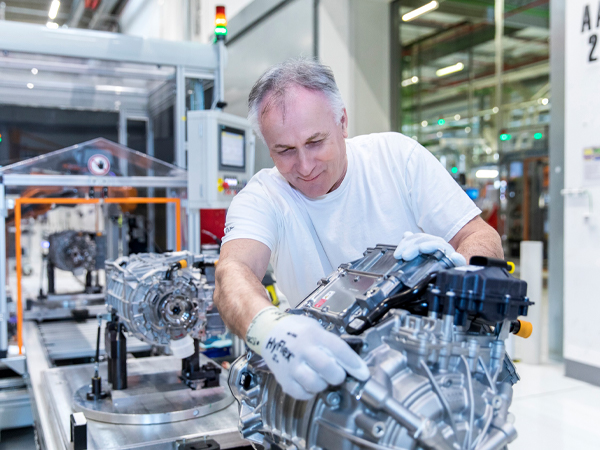
Some might think it would be better to skip this year when the world lost British monarch Queen Elizabeth II after 70 years on the throne. But not at Audi Hungaria! In addition to nearly 30 years of engine and vehicle production, there is an ever greater emphasis on services that help build the competencies of our colleagues, as the site becomes a competency centre that serves the entire Volkswagen Group. The services, mainly related to the areas of Technical Development, finance, IT, procurement and the supply chain, will help make operations more integrated and efficient. Also this year, a decision is made to further expand the company’s future portfolio of electric powertrains. The investment, supported by the Hungarian government, further reinforces Hungary’s role in the global automotive industry.
It’s a great feeling working at a company where everyone knows the products. We can see them on the roads, and we know everyone who works at the company has in some way contributed to those cars reaching our customers. We also do our very best to assist our colleagues as quickly as possible.

HR Business Partner, Central Functions/Global Assignments, HR Consultant
